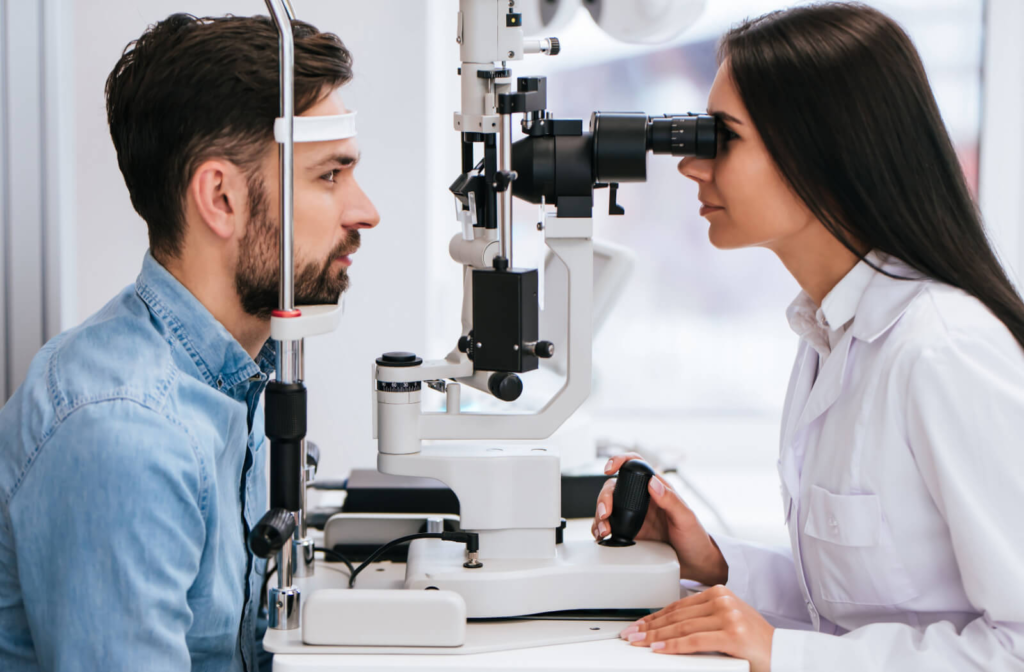When it comes to playing sports, your vision is more important than you may think. Your ability to track moving objects, judge distances, and react according to what you see are all important parts of your vision that can affect sports performance.
If you’re struggling with sports performance due to visual challenges, an optometrist can help. After a comprehensive eye exam, we can recommend exercises and programs to help train your vision and bring your game to the next level with sports vision therapy.
Learning about the visual skills that play a role in sports and how your vision is linked to your performance can help you identify areas of your vision and your athletic ability to target with training.
Visual Acuity & Clarity
Visual acuity is the clarity of your vision—how sharp images appear to your eye—and it forms the foundation of your visual capabilities. Your visual acuity can affect your ability to see fine details when you’re playing, alongside your ability to focus on and recognize objects.
When your vision is clear and sharp, you can discern subtle cues that you may not even consciously be noting, like a ball spinning as it’s coming toward you or the exact angle of an object’s motion. Strong visual acuity can help you make appropriate split-second decisions and react swiftly to the things around you.
Depth Perception in Sports
Depth perception is crucial for sports. The ability to see how far away a ball is or the trajectory of something coming toward you can help you know where you should be when throwing or catching—and help you time when to move. Depth perception can also help you see where your teammates and opponents are and time how they’ll be moving as well!
Having healthy depth perception can give you an advantage when it comes to playing many sports. Depth perception can promote spatial awareness as well by helping you understand your position in relation to everything else around you and providing an opportunity to make decisions quickly and react according to nearby movements.
Hand-Eye Coordination
Hand-eye coordination is your ability to use visual information and utilize your motor skills accordingly. In any sport that requires throwing, catching, hitting, or any hand movement, this is one of the most important functions of your vision.
An athlete with well-developed hand-eye coordination can track moving objects or players and move their body accordingly, making quick decisions so they’re where they need to be. Training your eyes to track moving objects while you execute precise movements can help improve performance for many sports that involve quick, dextrous, deliberate movements.
Peripheral Vision & Awareness
Your peripheral vision is a valuable part of your vision that’s often overlooked. Peripheral vision is your ability to naturally take in information outside your center of vision or direct line of sight. Your eyes take in light from all kinds of angles, and your peripheral vision helps you see things that you may not be consciously focusing on.
When it comes to sports, your peripheral vision is invaluable. You can subconsciously see other players or movements on the field without needing to shift your focus or spot a ball moving toward you if you’re looking elsewhere. Strong peripheral vision can give you the opportunity to notice things outside your line of sight, like an opponent moving toward you or a teammate moving into position.
Healthy peripheral vision can help you react fast and make quick decisions, all while remaining focused on what you’re looking at!
Reaction Time with Vision
Your reaction time is ultimately one of the most important things that can benefit you when playing sports. How quickly you take in visual information, process it, and make micro-decisions are all directly included in how you react, so keeping your eyes healthy can be incredibly important for supporting your reaction time.
Reaction time plays an important role in analyzing the actions of everything around you and responding effectively, from timing your movements and reacting quickly to changing direction based on sudden adjustments on the field and processing auditory or visual cues.
Reaction time is also vital when it comes to avoiding injuries. If you suddenly slip or get hit from behind, a fast reaction time can give you the ability to make micro-adjustments and avoid injury—not to mention collisions or hazards while playing!

How to Improve Vision for Sports Performance
Your vision is one of the most important factors in your athletic performance, so it’s critical to take care of it and train it when necessary. You should visit an optometrist for a comprehensive eye exam at least once a year so you and your eye doctor can monitor changes to your vision and keep your sight clear.
If you’re looking to step your game up, sports vision therapy can help. Sports vision therapy is a form of personalized treatment with programs and exercises designed to train your vision for specific goals. Taking the step to improve your vision can help support the visual skills needed to perform well at your chosen sport.
Schedule an appointment with us at Dr. Bladh, OD to speak with an experienced, caring eye care professional and learn more about how your vision relates to your sports performance.



